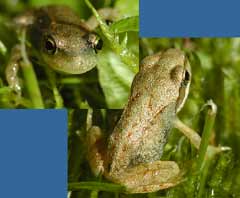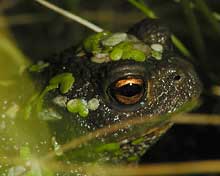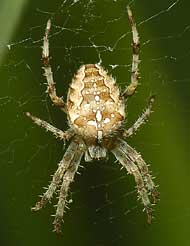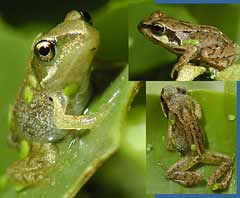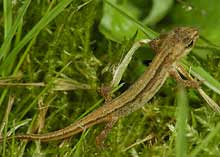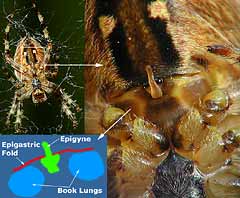Go to latest entry.....................................Go to previous entry23 August - Despite my neglect the ponds have thrived during the recent good weather. In fact, plant growth has been so vigorous that barely any water surface could be seen when we returned from our holiday. I have started thinning out some of the growth, but it will take time as I check for young newts - none found so far, although I did spot an adult hunting in the undergrowth at the side of the big pond.
There are a good few juvenile frogs about (from the last couple of years) as well as a couple of dozen mature individuals. There has not been much rain recently and when I used a hose to fill the birdbath I spent a few minutes spraying the area under the Hawthorn. Within a couple of minutes 16 frogs were heading into the wet area from the pond, presumable in search for insects or worms disturbed by the 'rain'.
It was a rare but very welcome sighting of a toad in the pond. A young individual, it was very wary and retreated back into the water as soon as I took this photograph.
Among the taller pond plants there are two large Garden Spiders (Araneus diadematus) perched at the centres of their orb webs. Very common spiders, they are, nevertheless quite an impressive sight when fully developed.
It is noticeable how they are able to climb steeply sloping vegetation quite easily. I may be wrong, but they seem to be able to used the surface tension of the water to act as a 'glue'. In the left-hand image the frog is clinging to an almost vertical leaf surface.
As with any clearing done by the ponds, grass cutting has to be done carefully, not just because of the presence of the frogs, but also newts and caterpillars (see the garden diary for the latter). I found a couple of these miniature newts (about 3cm long) that seemed to be hunting in an area rich in small insects.
30 August - Since my last entry the felling of the Leylandii has distracted me from the pond once again and a lot of clearing still awaits my attention! While I had my camera with me in the garden for the first time in several days, I took the chance to get in close to the Garden Spider pictured above as she continues to maintain her orb web between the Iris leaves. The main image shows some details of her underside, concentrating on the area outlined in the white box. The structure in the middle is the epigyne. This is a structure that only appears on adult female spiders. It is part of the female's genital opening and, because its shape is characteristic of each spider species it is important for identification purposes. The epigastric fold marks the front end of the spider's abdomen. Just in front of it, and either side of the epigyne is a pair of book lungs, the positions of which are indicated by the light coloured circular areas. The name comes from their structure, which consists of layers of blood filled tissue with air spaces between them. The lungs open to the outside via slits by the epigastric fold. |
|
